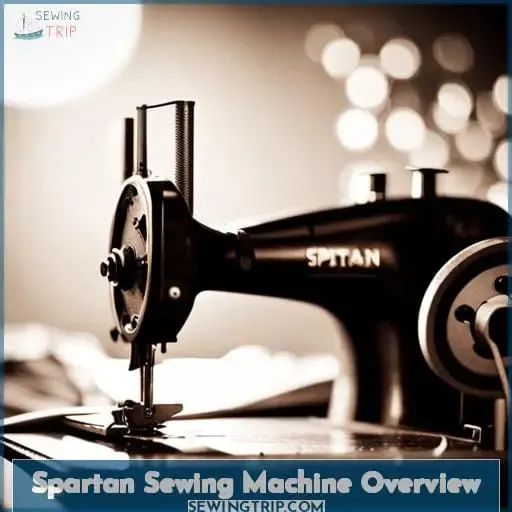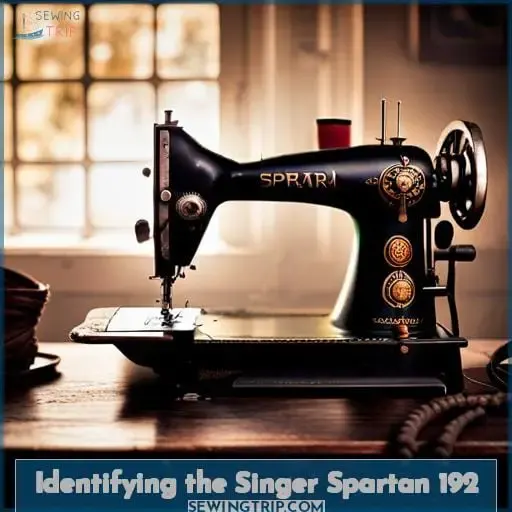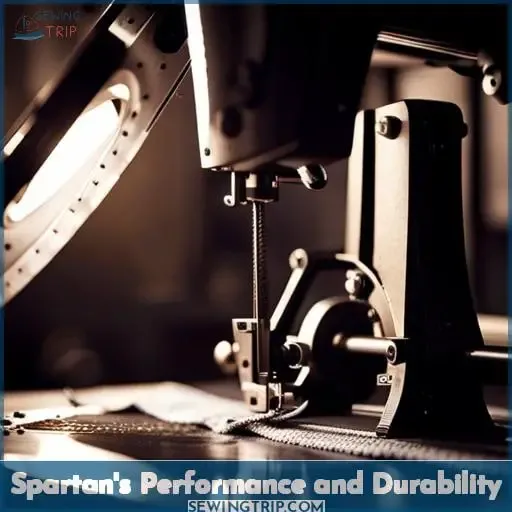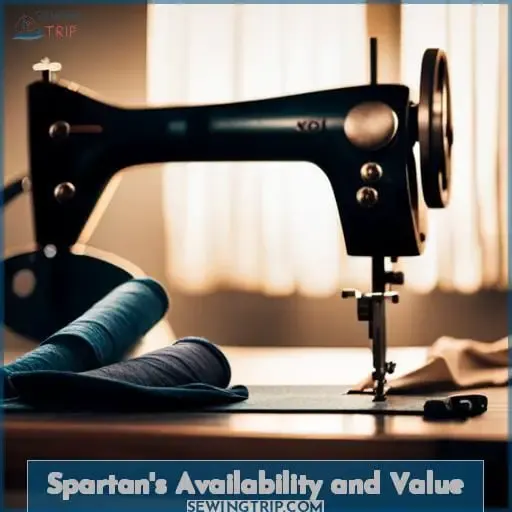This site is supported by our readers. We may earn a commission, at no cost to you, if you purchase through links.
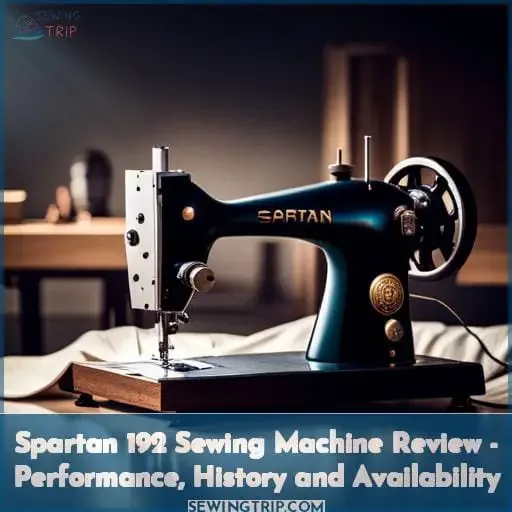 Imagine yourself as a tailor in a bustling city, surrounded by bolts of vibrant fabrics and the gentle hum of sewing machines.
Imagine yourself as a tailor in a bustling city, surrounded by bolts of vibrant fabrics and the gentle hum of sewing machines.
Among your tools, the Spartan 192 stands out, a sturdy and reliable companion in your creative journey. Its sleek design and robust build hint at a rich history and exceptional performance.
Let’s embark on a journey to uncover the secrets of this iconic sewing machine, exploring its features, durability, and availability in today’s market.
Table Of Contents
Key Takeaways
- Affordable, heavy-duty workhorse model by Singer, stripped down to essential parts for smooth performance
- Short production run makes Spartan models historically significant and appealing to collectors
- Robust, quality design and construction for durability, handles heavy fabrics despite lacking conveniences
- Good value for vintage enthusiasts but challenging to find, pricing varies based on condition
Spartan Sewing Machine Overview
With its simplistic design and lack of bells and whistles, the Singer Spartan 192 sewing machine lives up to its name by providing a no-frills, heavy-duty workhorse for sewers on a budget.
Based on the popular Singer 99 model, the Spartan 192 features the same sturdy construction but pares the machine down to just the essential parts needed to efficiently tackle sewing projects.
Without non-functional ornamentation driving up the cost, the Spartan 192 delivers that vintage Singer quality at a more affordable price point.
At first glance, the Spartan may be mistaken for the very similar-looking 99K.
But upon closer inspection, one notices the Spartan’s signature Spartan label displayed prominently on its face along with the absence of details like gold accents.
Weighing in at a portable 11 pounds, this 3⁄4 size machine features smooth performance whether sewing multiple layers of thick fabric or simpler projects.
Its plastic base gives it a lightweight advantage over the 99’s cast iron body while still providing stability during operation.
For those seeking serious sewing abilities without extravagances, the Spartan 192 offers unmatched value without compromising on power or precision.
Spartan Sewing Machine History
From discussing the overview of the Spartan sewing machine, you’re learning Singer is a world-famous manufacturer that created the Spartan as a quality offering comparable to Volkswagen’s famous Beetle to compete against low-end imported machines in the market.
As a sewing enthusiast, you appreciate that the Spartan carries on Singer’s legacy of high-quality manufacturing while evolving to meet changing market needs.
Despite its short production run before being discontinued, the Spartan holds historical significance as Singer’s attempt to maintain market presence against low-cost imports.
For collectors and vintage sewing fans, the Spartan stands out with its focused design that epitomizes simplicity and function over features, making it a fascinating piece of Singer’s manufacturing evolution and a unique collector’s choice that reflects historical trends.
Though spartan in amenities, it performs as well as Singer’s other robust models – a true testament to quality design and construction that still appeals today despite lacking modern conveniences.
Identifying the Singer Spartan 192
You’ll find identification challenging due to missing or incomplete model numbers on these machines.
Further clues to identifying the Spartan 192 include:
- No Featherweight label, only a small 192 model number plate
- Prominent Spartan label across the front
- Singer name inside the harp
- Model number 192K on the stitch-length lever
- Class 66 drop-in bobbin
- Belt-drive Simanco motor
The Spartan 192 is a 3/4 size machine, smaller than the 15-91 but larger and heavier than the 221 Featherweight.
When placed side-by-side with the 99K, the Spartan appears strikingly similar in size and shape but lacks gold-leaf decoration, the Singer badge, task light, and auto-stop mechanism on the bobbin winder.
The Spartan embodies its name with a simplistic Bakelite box base sans cover or carry case.
Despite its stripped-down, spartan design, the 192 performs heavy-duty sewing tasks comparably to the 99K and Featherweight.
Spartan’s Performance and Durability
Designed for toughness, a properly adjusted Spartan can handle heavy-duty sewing tasks like the Singer 99K or Featherweight.
Though devoid of luxury features, the Spartan sewing machine is a reliable and durable workhorse. It’s built with sturdy cast iron construction to withstand years of sewing projects.
This budget-friendly option performs on par with the Singer 99K and Featherweight models. It can handle multiple layers of heavy fabrics like denim thanks to its adjustable presser foot pressure.
You can count on the Spartan’s long-lasting durability to complete sewing tasks on any fabric type.
Much like the Singer 99K, the Spartan sewing machine is a tried-and-true vintage workhorse that doesn’t sacrifice reliability for affordability.
Sturdy and steadfast, the Spartan stands the test of time as a heavy-duty sewing machine perfect for quilters, crafters, and home sewers seeking quality on a budget.
Spartan’s Availability and Value
Coming from its stripped-down yet reliable design, the Spartan offers great value for vintage sewing enthusiasts.
Though challenging to find at first, exploring thrift shops, estate sales, and even asking around quilting circles can turn up Spartan sightings.
Once found, prepare for smiles upon seeing its cute compact frame awaiting a new home.
Online marketplaces occasionally list Spartans too, pricing ranging based on condition and included accessories.
Paying over $100 seems high unless it’s mint; the going rate falls around $50-75.
As awareness spreads of Spartans’ capabilities equaling Singer’s 99k and Featherweight models, its resurgence gains momentum.
More quilters realize that unlike some modern computerized machines, the Spartan simply works – no dancing lights or digital disruptions.
Just insert thread, nestle fabric under the presser foot, and watch straight stitch perfection unlock.
For those desiring precision at an affordable price without new-fangled fluff, Spartans offer the perfect solution.
Frequently Asked Questions (FAQs)
What type of needles and bobbins are compatible with the Spartan sewing machine?
The Spartan uses standard class 66 bobbins and common 15×1 needles that are widely available.
These are the same as found in many other vintage Singer machines.
Check your manual to ensure you get the right components, but most retailers carry compatible needles and bobbins.
Does the Spartan sewing machine have a power switch?
Unfortunately, no.
The Singer Spartan sewing machine does not have a power switch.
For optimal longevity, unplug the power cord when not in use rather than relying on an on/off switch.
This reliable, no-frills model focuses on delivering straight stitch perfection rather than extra convenience features.
What is the motor type and power source for the Spartan sewing machine?
You’ll find the Spartan powered by a classic Simanco motor.
This reliable unit gives you solid power and control to handle your sewing projects with ease.
Depending on the model, the motor is connected to a foot control or wall plug.
What accessories and presser feet come with the Spartan sewing machine?
The Spartan comes with basic presser feet for hemming, binding, rolled hems, edge stitching, ruffling, shirring, tucking, and installing zippers or cording.
As a no-frills model, it lacks decorative stitch options and advanced presser feet found on other Singer machines.
Focus is on reliability over features with this workhorse.
How do I adjust the stitch length and tension on a Spartan sewing machine?
Place the thread in the tension discs and stitch selector.
Adjust tension by turning the dial, and length using the lever.
Test fabric swatches to find optimal settings for your project.
Periodically check tension as you sew.
Conclusion
With its robust construction that’ll last through generations of seams, the Spartan 192 remains an heirloom investment.
Like a trusty pair of jeans worn through years of adventures, this classic machine delivers reliable performance tailored to crafters who still prefer precision mechanics over flashy electronics.
For those seeking a workhorse that’ll stitch circles around modern models, the Spartan 192 stands the test of time.

